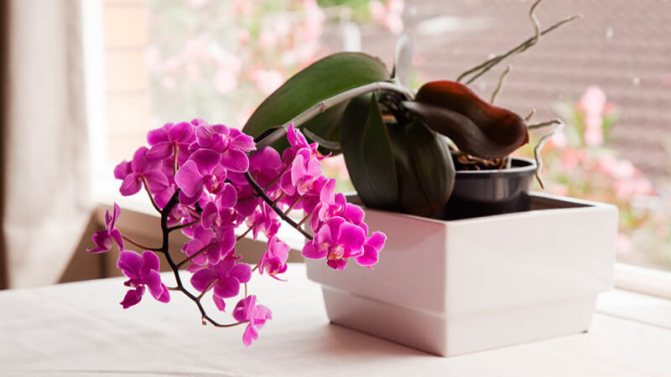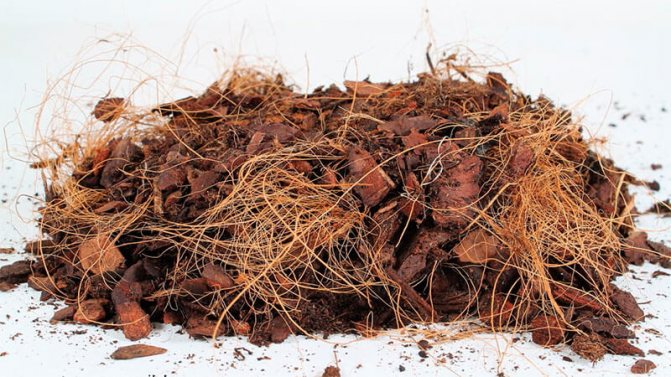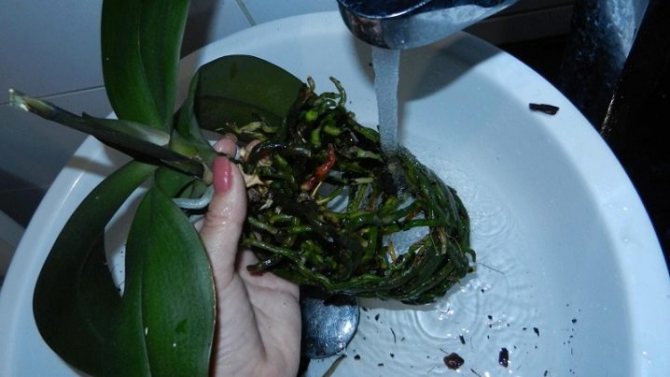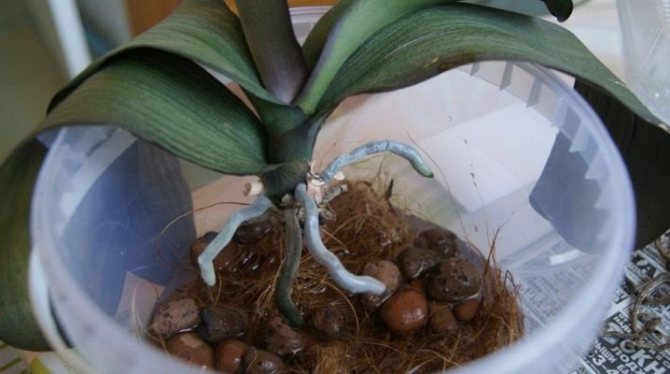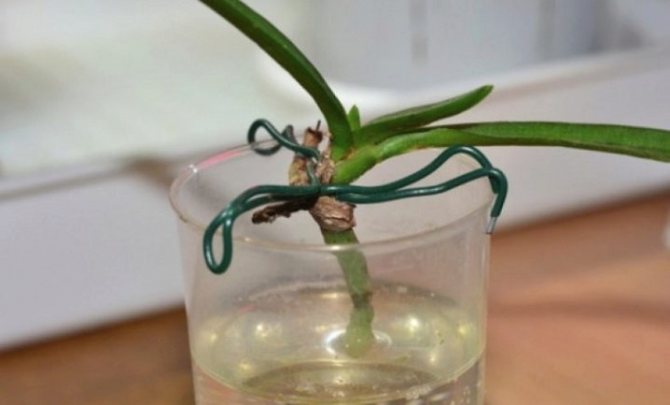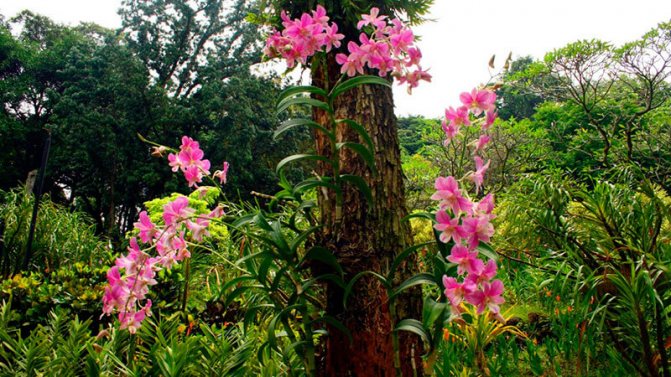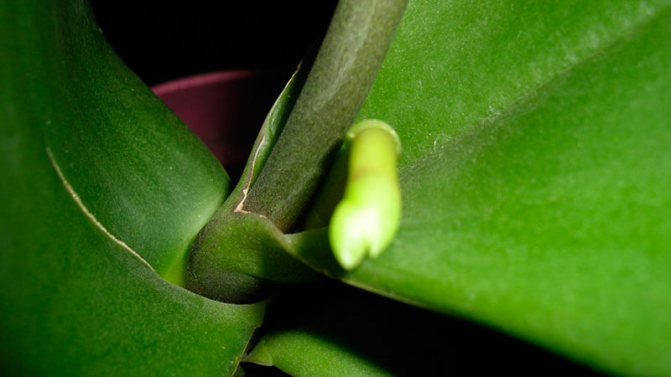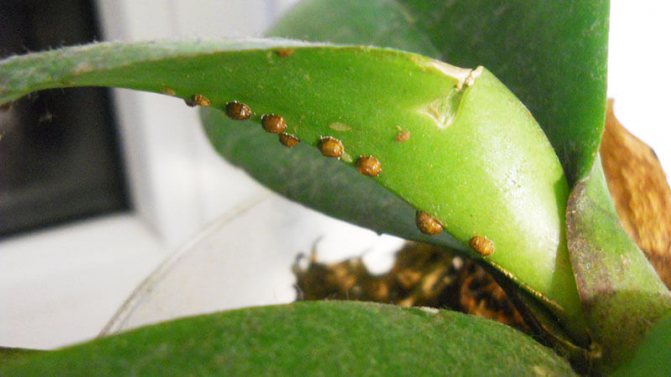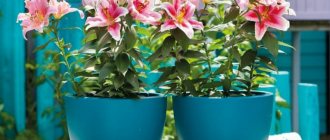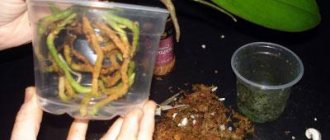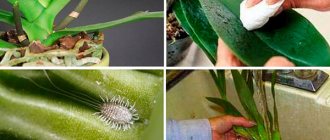Orchids are beautiful flowers that delight with their variety of colors all lovers of beauty and ordinary people who do not harbor special feelings and desire to grow plants on their own. Initially, the story of their appearance begins in the wild. These flowers could only grow in tropical areas, requiring a large number of plants and trees around them.
Today, hybridizers have bred several varieties that feel quite well and comfortably in home pots under artificial lighting. Such opportunities attract florists and housewives to self-cultivate this beauty. Consideration should be given in detail to the question of whether how to grow and how to care for an orchid at home.
All About Orchids: A Practical Guide To Growing And Care
Of the many varieties of orchids, only about 10 species are suitable for home cultivation... Hybrid forms are the most adapted, and for species forms, more stringent requirements for conditions and care are required.
When purchasing any type of orchid, you should find out the characteristics, features and tips for organizing the conditions for growing. Knowing how these beauties grow, it will be easier to organize their care.
For light-loving orchids, a wide windowsill and additional moisture are usually required. Some varieties, on the contrary, need partial shade in order to fully develop and grow.
Some varieties can bloom almost all year round, while others bloom only once a year for several weeks or months.
There are two approaches to raising such exotic pets in an apartment.
- You can purchase a blooming orchid and after several months of flowering, it will get rid of it... Some gardeners do this without bothering with care.
- But the bulk of home gardeners prefer keep orchids on an ongoing basis and even breed them. Of course, in this case, you will have to make some effort, but the result is worth it.
The most popular types of orchids for home growing:
- Phalaenopsis;
- Dendrobium;
- Brassia;
- Cambria;
- Cattleya;
- Cymbidium;
- Lycast;
- Miltonia;
- Odontoglossum;
- Paphiopedilum.
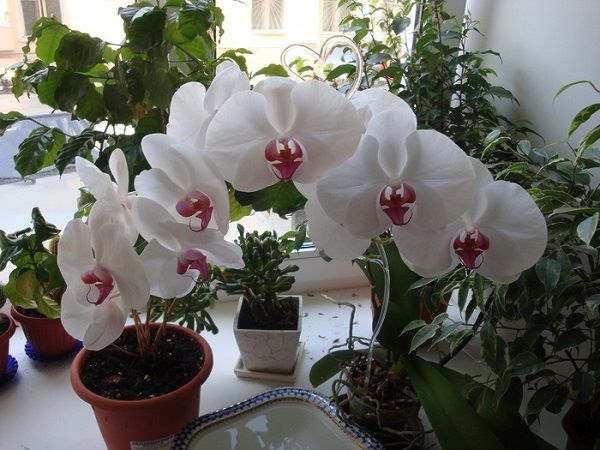
Phalaenopsis is the most popular indoor orchid.
Attention! Each of them requires the creation of certain conditions and appropriate care.
Read more about growing orchids at home in this article.
Causes of poor growth
Growing problems can manifest as poor orchid growth. There are many reasons for poor growth. And in order to activate the process, it is necessary to accurately determine the cause of such a phenomenon. In 90% of cases, this is due to improperly created conditions or improper care of the plant.
The main ones are:
- the temperature regime has not been sustained;
- lack of lighting;
- exceeding or decreasing the limits of air humidity;
- incorrect selection of capacity;
- violation of the rules for watering and feeding;
- diseases and pests.
Another important reason is violation of the rhythm of plant growth. Each species of orchid is genetically inherent in the alternation of growth and dormancy. Violation of the growth rhythm can stop the development process for quite a long time. All of the above reasons can be a failure of this process.
You can learn more about the reasons for poor growth in this article.
How to get babies?
Baby is a young scion or an escape, formed on the stem, peduncle or roots of orchids. The main reason for their appearance is inherent in nature continuation of the genus (offspring).
If in nature the appearance of children occurs independently, then with home growing of orchids only providing competent care will enable the baby to be born. As a last resort, you can stimulate its appearance.
Some orchids have babies one or more at a time. instead of a flower anywhere in the peduncle. In this case, it is recommended to separate it from the mother part when building at least 3-4 roots with a length of at least 5 cm.
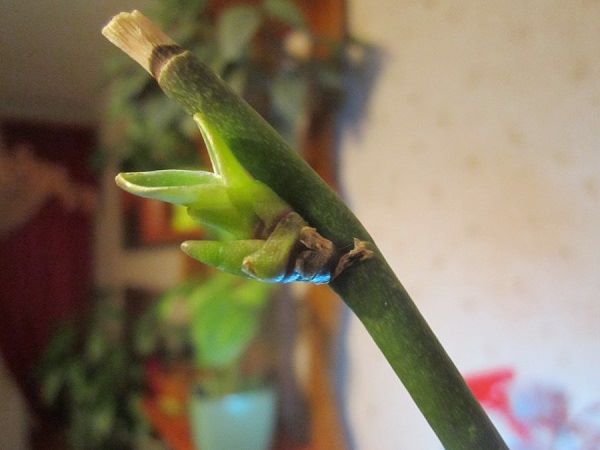

Orchid baby on a peduncle.
In most cases, babies appear at the roots.... The separation is more difficult, as there is a risk of damage to the roots of an adult orchid. With careful and correct separation, such a process takes root well and develops quickly enough.
Kids may appear on the stem. But their separation is unsafe, since they do not have their own roots and with unfavorable separation, the plant itself can be destroyed with a high probability.
Raising children, although laborious, is an interesting activity. It is placed in wet moss - sphagnum, wrapped in foil and placed in a warm, well-lit place.
Important! When growing roots, it is necessary to observe the duration of daylight hours at least 12 hours.
After root formation, it is placed in a small transparent container (plastic cup) with drainage and quality substrate.
Can be placed in a small greenhouse, which must be ventilated daily and monitor the moisture content of the substrate.
Some growers recommend grow in foam or by hanging children, covered with a glass, over a container with a substrate mulched with wet moss.
After good rooting, the baby is placed in a permanent growing area with a high-quality substrate specially designed for orchids.
Read more about reproduction by children in this article.
Choice of substrate
Orchid roots firmly adhere to the particles of the substrate, gradually crush it, drawing out moisture and nutrients. Therefore, the best substrate is boiled pine bark mixed with coconut chips and sphagnum moss (other types of moss cannot be used).
Selection of substrate:
- adult orchids are allowed to be planted in bark alone (without moss) or in bark with 10–20% moss;
- for mini-phalaenopsis, the substrate should contain 40-50% sphagnum moss, the rest should be smaller than for large orchids, pieces of bark and coconut chips;
- for healthy, well-developed children (with several roots 4–5 cm long) - 50–70% moss;
- for "adolescents" of large orchids - 20-30% moss (the flower must be gradually accustomed to a substrate consisting of one bark);
- children with poorly developed roots and diseased plants are nursed in a moss substrate, without adding bark.
For drainage, you cannot add to the pot:
- expanded clay;
- foam (it does not absorb water);
- perlite and vermiculite, as they secrete substances that slow down the growth of phalaenopsis.


Orchid propagation
There are many ways to grow an orchid yourself.
Comprehensive information on the methods of orchid propagation can be found here.
Seeds
Attempts to grow an orchid from seeds at home almost impossible... The seeds are so microscopic in size that it will be quite troublesome to do this without a special laboratory, tools and nutrient medium. The process of such reproduction is very complex and long, taking from 4 years or more. to get a viable plant.


Orchid seeds are very small.
For more information on whether it is possible to grow an orchid from seeds, read this article.
How to germinate?
The cultivation technique includes several stages.
First of all a sterile substrate is required. In laboratory conditions, agar-agar is used for this purpose, which is a mixture of polysaccharides extracted from seaweed. Fans of home breeding use Knudson's nutrient medium, which is made according to a special recipe and does not have symbiosis with a special mushroom.
Some florists use sphagnum, but for this it is finely crushed, sterilized and filled with special nutrients. Moreover, throughout the entire period of germination its acidity is maintained at a certain level.
Plus to everything special containers are required, such as flasks, jars, sterile and with screw caps.
Seeds are sterilized before sowing in calcium hydrochloride and only then quickly, over steam, are transferred into a sterilized nutrient mixture and container.
Observing greenhouse conditions, cleanliness, care, conditions, sprouts appear in 3-9 months, depending on the type of orchid. But a plant ready for planting will only be in 2-3 years.
You can read more about the cultivation technology here.
Leaves or roots
Unfortunately, it is not possible to grow an orchid from a leaf or root... Orchids do not reproduce or grow in this way.
For more information on whether it is possible to grow an orchid from the root, read this article.
By shoots
The easiest and most reliable way of breeding and growing for beginners is from a baby that has formed on a peduncle. To get a positive result, you should adhere to the following rules:
- when a baby appears, spray the plant more often, thereby activating its growth and release of roots;
- separate it only after the release of 3-4 leaves and the length of the roots of at least 5 cm and no more than 7 cm;
- if necessary, it is necessary to stimulate education and growth with special growth preparations;
- having separated the baby with a sharp instrument, it is necessary to leave 1 cm on each side of the faded flowering arrow;
- process the sections with crushed activated carbon;
- place it in a substrate specially prepared according to all the rules;
- create a warm and humid climate with a greenhouse or small greenhouse;
- provide a sufficient amount of lighting - at least 10-12 hours of daylight hours.
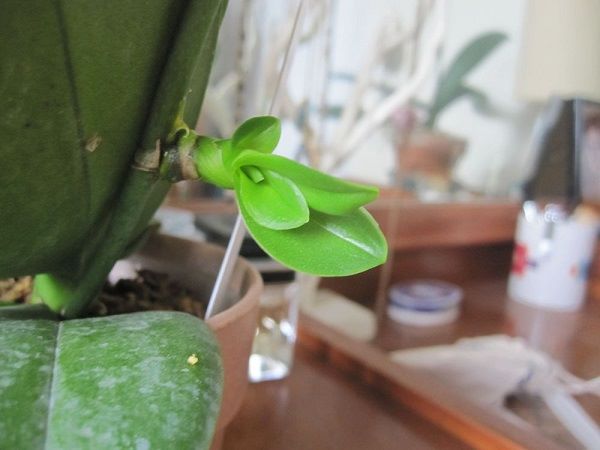

The easiest way to reproduce is by shoots.
Having fulfilled such simple conditions, the baby is able to turn into a well-developing plant and bloom next year.
You can get more information on growing from scions here.
Cuttings
Sometimes the propagation of orchids "from a leaf" is confused with cuttings, since the top of the lateral shoots or the peduncle itself is cut. The process is lengthy, requires some labor, but quite effective.
Important! Cuttings are prepared only from a completely faded peduncle.
Cuttings cut from the lateral shoot, must contain at least 2 internodes. Usually 2-3 are left. Places of cuts are treated with activated carbon and dried well.
Then they are placed horizontally into a container with moist soil and create a greenhouse effect with film, glass or a small plastic container, creating good moisture and maintaining temperature not lower than 28-30 ° С.
In one day watering and airing the greenhouse is carried out. Condensation on the inside is not allowed. Periodically, every 10-15 days it is advisable to feed with several times reduced concentration.
Such conditions and care are carried out until the roots of dormant buds are formed and until their length is 3-5 cm. Then the cuttings are separated and planted in a new soil.
For more information on how to properly grow orchids from cuttings, read this article.
Resuscitation
Phalaenopsis is very tenacious. Even a plant with rotten roots and two leaves is capable of releasing a baby on a peduncle. The main thing is to remove the rotten parts. All diseased tissues are cut with a sharp clerical knife.
To disinfect wounds, they are treated with gruel from a small amount of "Fundazol", ground in a few drops of water. Leaves from above and below are wiped with a swab dipped in a solution:
- 1 liter of water;
- 5 g "Fundazol";
- 1.5 ml Previkura.
Both of these drugs are systemic fungicides that are effective against rot. Previkur also stimulates root formation and growth of phalaenopsis.
It will take 2-3 weeks for the wounds to heal. During this time, the area treated with fungicide gruel must not be moistened. The plant is placed over a jar of water so that the lower end of the stem does not touch the liquid. Every day, the leaves are thoroughly wiped on both sides with a swab dipped in a solution of succinic acid (1 g per liter of water). The shelf life of the solution is 3 days. Another 1-2 times a day, the leaves are moistened with plain water.
After 2 weeks, the plant is again wiped with a solution of fungicides. Healthy phalaenopsis cannot be treated with fungicides for prophylaxis.
When the wounds heal and the danger of decay has passed, a pot (disposable glass, tray) with a hole in the bottom is filled with dry sphagnum and the substrate is moistened with distilled or boiled water. The diseased plant is planted in moss.
A recovering phalaenopsis needs warmth and diffused light (it is useful to organize the backlight so that the daylight hours are 15-16 hours). You can arrange a greenhouse by covering the pot with a large plastic bag. Every day, the greenhouse is opened for 15 minutes, the bag is turned inside out, removing condensation, and the leaves are wiped with a solution of succinic acid. The substrate should be moderately moist, it should not be allowed to dry out.
How to grow an orchid at home?
Let's take a closer look at how to properly grow these whimsical exotic beauties at home.
From a cut peduncle
Rarely used method when growing at home. It is used if there is no possibility or formation on the plant itself. After the peduncle has faded, it is cut to the very base. Dormant buds must be present on the trimmed flowering arrow.
The peduncle is placed in a container with water with the condition of placing the kidneys above the water level... The main task for the grower is to control before the emergence of bud germination. They usually germinate for about 3 months, but if necessary, this process can be accelerated with special stimulating compounds.
Later, with the appearance of 3-4 leaves and the formation of roots of 5 cm, the baby is transplanted into the substrate with the provision of the conditions and care described above.


Germination of buds on a cut peduncle.
The positive fact of growing in this way makes it possible to germinate several shoots from the peduncle at once, since when in a container with water, several buds can awaken at the peduncle at once.
Advice! It is important to protect it from direct sunlight.
Read more about getting an orchid from a peduncle in this article.
From the onion
It would be more correct to call not an onion, but a pseudobulb - tuberous thickened parts of shoots, serving as accumulators of nutrients and moisture in sympodial orchids.
Outwardly, it may resemble an onion, although this is not necessary. The main thing is that it is located in the above-ground part and has a green color. Different types of orchids have “bulbs” of different sizes and shapes.
They are obtained by dividing the bush. Three conditions are necessary for growing: bulb, container and soil. This is enough to get a well-growing plant.
Exists two ways to grow an orchid from a bulb:
- Air. Without substrate, capacity, watering, spraying, but with good and sufficient lighting. After about a month, villous roots appear and then the pseudobulb can be transplanted into high-quality soil;
- Standard. The substrate is poured into a plastic pot with drainage holes. An onion is installed on it and covered with sphagnum. The moss is periodically sprayed. Adequate lighting and humidity are created.
After good rooting, they begin to transplant into a container corresponding to the size of the root system and provide care according to the instructions for caring for orchids.
Find out more about bulb orchids here.
From vietnam
Varieties Paphiopedilum - the most popular Vietnamese orchids among flower growers... The bulbs of these orchids are brought not only by tourists, but in recent years they can often be found in flower centers. And although there are many varieties of Pafiopedilum, their cultivation is identical.
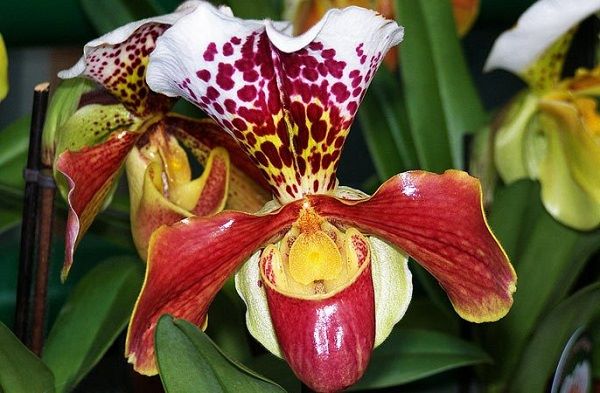

Paphiopedilum.
If we grow Paphiopedilum from an onion (bulb), brought or purchased in bottles, then before proceeding with planting, they should be kept for some time in the purchased container in your roomso that they can acclimatize and get comfortable.
It is better to have a transparent container for plantingso that you can observe the development of the bulb. Also, there must be a sufficient number of holes in it for excess moisture to escape and for good air circulation.
The container, according to all the rules inherent for orchids, is filled with a substrate, which is better to buy ready-made in a flower shop. The bulb is deepened into a wet substrate by 1 cm and is propped up for stability with a prepared peg. Bulb container installed in a well-lit place.
Advice! In order for the bulb to develop well, it needs some care and attention.
The next watering is carried out after the appearance of the first roots. AND after about a month, the sprouted bulb is transplanted into a container for a permanent growing place.
Like most orchids, Vietnamese Pafiopedilums prefer good, diffused sunlight, a certain temperature and humidity:
- temperature not lower than + 18 ° С and not higher than + 35 ° С;
- humidity from 50% to 80%;
- the amount of daylight hours is 10-12 hours.
Care:
- watering - as the substrate dries up;
- monthly feeding special fertilizers for epiphytes, reduced concentration by 3-4 times;
- periodic spraying.
Usually, for the full development and full blooming of the Vietnamese bulb, 4-5 years old.
Read more about growing from bulbs from Vietnam in this article.
Types of orchids and their features
Orchid varieties so diverse that they are rightfully divided into indoor varieties and wild ones. But housewives and florists are not worried about such divisions, so almost all the flowers they like are used for growing at home.
There is a similar article on this topic - Reproduction of an orchid at home.
Orchid flower meaning directly affects their popularity. So, these luxurious flowers personify the symbol of love and aristocracy. Today flowers bring more harmony and family comfort to the house.
The Chinese personify an orchid with a symbol of fertility and use it as a talisman against impotence (including sexual). Therefore, these flowers can be found in China in almost any home.
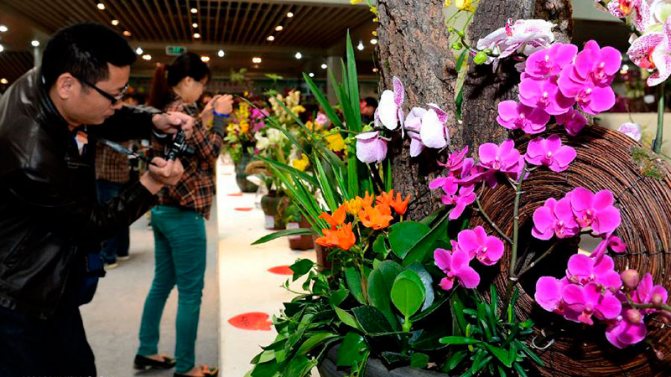

Varieties of orchids for growing at home
Orchid care for beginners - this is the main question of many housewives who want to grow the presented beauty on their windowsill.Since some varieties require special care, experienced florists recommend the following types for growing at home:
- Sympodial orchids - have the peculiarity of storing the obtained useful substances in pseudobulbs, which makes them unpretentious and simple varieties of flowers for growing at home. Another feature lies in the properties of self-renewal. As soon as one bud fades, new ones come in its place. Such transformations occur regularly, so the beauty on the windowsills will delight housewives all the time. Such varieties include orchid varieties such as Cattleya, Cymbidium, Dendrobium and others.
- Monopidial varieties - often have one straight stem of low height (on average, up to 15 cm). Leaves and buds emanate from the stem. Depending on the life of the stem, new buds appear. The varieties include Wanda, Phalaenopsis.
Despite the unpretentiousness of the presented varieties for self-cultivation, they also require adherence to simple care rules, which include regular watering at regular intervals and the implementation of the procedure for transplanting and propagating a plant.
Orchid types: photos and names
Today, orchids can be found in any flower shop in an abundance of varieties. To make the right choice, you should understand a little about the features of each of the most popular varieties. The following types of orchids can be distinguished here:
Phalaenopsis - the most popular variety, which, in turn, includes 70 sub-varieties. Its appearance resembles a "pillar" strewn with flowers with leaves growing from the base. This variety is often referred to simply Butterflyas the buds themselves resemble the shape of a butterfly. Those wishing to grow the presented variety should take into account that for their optimal growth, it is necessary to provide a lot of sunlight and heat. In addition to the above requirement, phalaenopsis is unpretentious. With proper care, the orchid will bloom at least three times a year. Each time after flowering, the top should be cut off by 4-5 cm.
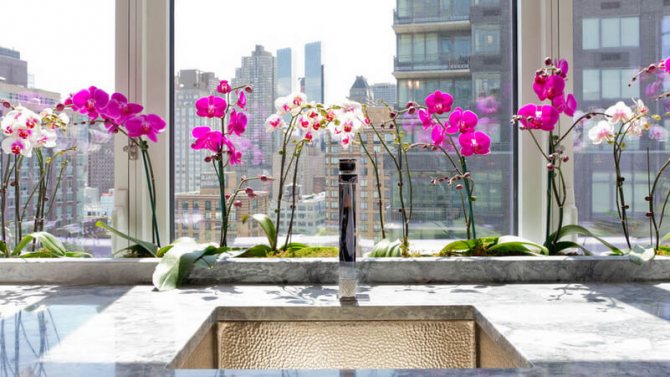

Cattleya Orchid - requires a lot of heat and light, which leads to the need for additional lighting in the winter. Cattleya is divided into two types: purple with white and flowers with a wide range of colors (the second type has corrugated edges at the petals). Most of the more than 50 sub-varieties bloom from April to November. The rest of the time, the plant rests, but also requires proper care. Cattleya requires regular fertilization during the flowering period.
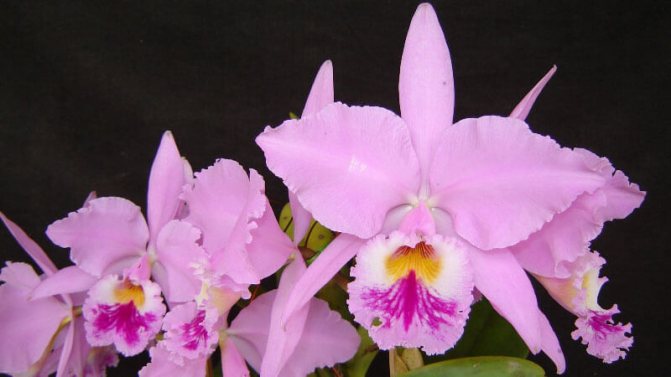

Bulbophyllum - includes about 2000 subspecies, each of which has a pungent smell, which is not tolerated by all lovers of beauty. The flowers of the presented variety grow in small buds along the shoot in two rows. Depending on the subspecies, flowering can be both winter and summer. For normal and comfortable growth, it is necessary to provide the flowers with warmth and sunlight.


Wanda - the only variety of the described plant that prefers to grow in the mountains and on the peaks, due to which the shoots can reach 1.5 meters in height. If you breed this variety at home, you should provide it with the most comfortable conditions, namely, plant it in a large pots and give it free rein to reach the maximum height (about 80 cm in length). In the axils of the leaves, one can observe a picture of the growth of several shoots with a large number of inflorescences. The Vanda variety is distinguished by its long stay in the water - cut shoots can stand for more than 10 days. Despite its "moderate thermophilicity", it is impossible to create conditions during cultivation with an air temperature below + 15 ° C - the plant may die.
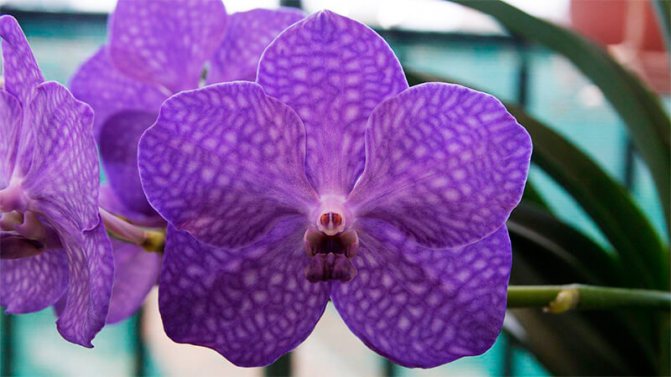

Dendrobium - has more than 1600 species.It differs in its place of growth - it grows on the crowns of trees. The inflorescences form a kind of brush with at least 15 buds. Flowering begins at the end of winter. Flowers delight the eyes until the beginning of summer. Dendrobium is hard to grow at home, since it is difficult for them to take root in the earthen soil, especially if a transplant has been made (reproduction of flowers is difficult and requires a lot of skill).
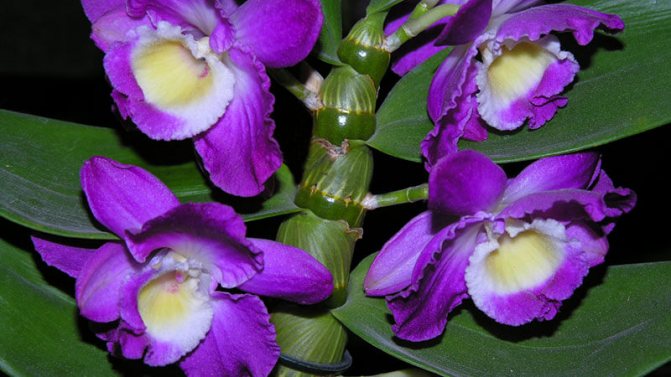

Miltonia Orchid - differs in color and shape of its leaves. Its long, oblong leaves can be gray or yellow. There are no more than 20 sub-varieties here, where red and pink shades are especially popular. This variety loves warmth, but will do well in partial shade. Planters with Miltonia can be kept on the windowsill on the west or east side all year round.
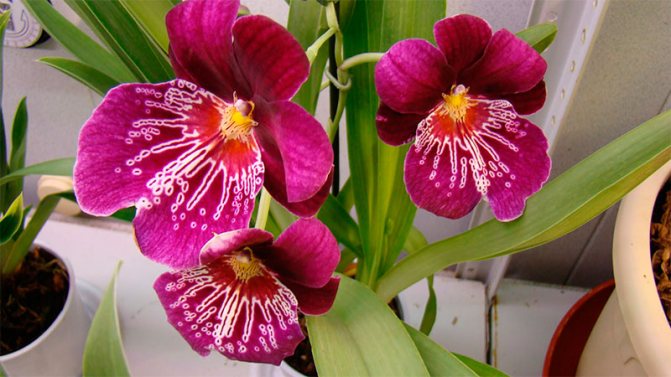

Ludisia Orchid - has not gained popularity among those wishing to grow plants at home. Such "dislike" lies in the nondescript color of the buds themselves. The flowers reach no more than two centimeters in diameter, and their color is limited to a pale yellow shade.
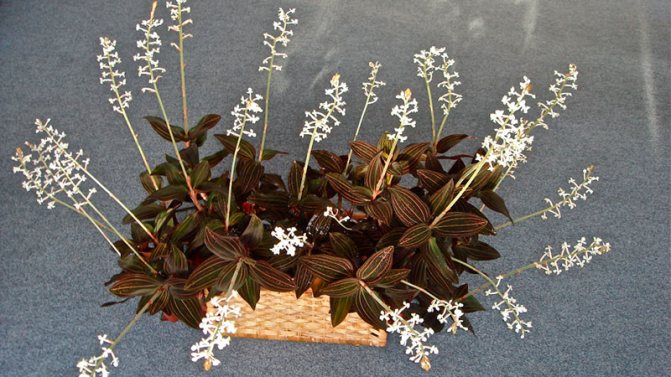

These are not all types of orchids. Before purchasing and growing a plant on your own at home, you should study the information about each variety you like.
The best places to keep
Orchid can be grown anywhere as long as the location meets the required conditions... At the same time, do not forget about the correct choice of capacity in what to grow an orchid.
You can get all the comprehensive information about the places where orchids are grown here.
Window
- northern - most unsuitable for growing tropical plants. The lack of lighting both in winter and in summer will have to be compensated for by additional lighting;
- western - not much better than the north window. There is also a lack of light;
- eastern - a comfortable window for the summer period, but additional lighting is required in winter;
- southern - the most successful window for growing orchids. But you should protect the plant from direct sunlight and ensure that the required moisture is maintained.
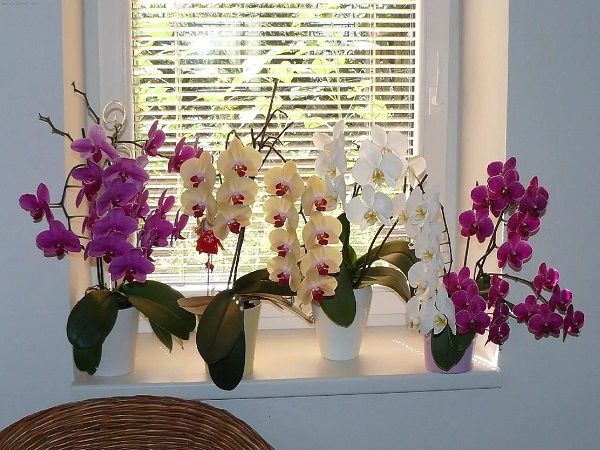

Orchids on the south window should be shaded from direct sunlight.
Blocks
The most natural way for orchids to grow. The arrangement of baskets or bark blocks on the walls or even the ceiling in the room is not only natural for epiphytes, but also attractive for the grower. The method is quite laborious to maintain due to the maintenance of moisture and rationing of irrigation.
Location on
Probably, the most inefficient way. Of the large group of orchids, only northern (terrestrial) orchids can grow on the site. And then, the success is in great doubt, since it is difficult to maintain symbiosis with a certain type of mushroom.
In the greenhouse
In a moderately warm greenhouse most tropical orchids can be cultivated. Epiphytes can be grown on branches or trunks of dry trees. Can also be cultivated in flower pots.
It can be considered a positive effect that there is a natural difference in the greenhouse between night and day temperatures, that almost all orchids love.
In the apartment
The most common cultivation method.
Bloom
Orchid bloom can last up to six months, since her flowers on the peduncle bloom gradually. The flowers are on average 9 cm in diameter and have various shades of red: from pale pink to maroon.
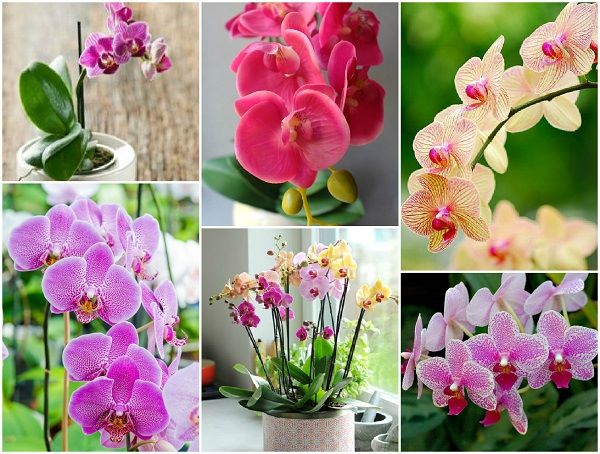

Blooming of different varieties of orchids.
Therefore, watering the plant during flowering, you must adhere to certain rules:
- water should not get on the flowers - they lose their appearance and wither;
- water should not accumulate in the sinuses of the leaf plates - this causes the development of fungal diseases and the death of the bush;
- watered only with warm water, removing excess water after watering;
- the soil should not dry out completely.
When watering an orchid of any kind, remember that it is better to underfill than to fill it. After all, from excess watering, the flower begins to rot the root mass.
IMPORTANT! If the water after watering remains in the sinuses of the leaf plates, it must be carefully removed with paper napkins.
Cultivation methods
In glass vases
Growing in glass vases new orchid growers should wait a bit and gain experience and knowledge. The method of growing in glass is quite attractive and aesthetic, but requires certain skills, knowledge, as well as certain nuances.
The optimal shape of the vase is the "glass" shape when the base is wider than the neck. This gives the plant increased resistance and more free root development.
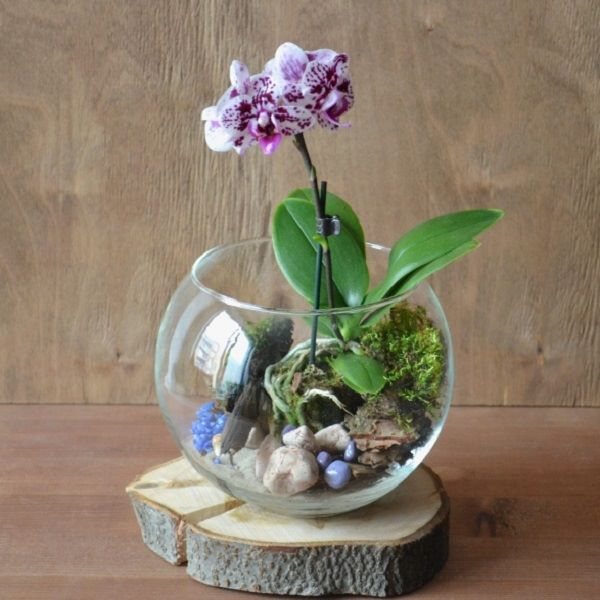

Orchids can be grown in glass vases, but it takes knowledge and effort.
The orchid is not completely immersed in the container, but is suspended by some devices at a certain level in order to prevent the root system from suffocating... Some experienced growers use inert drainage to protect the root from decay. But a feature of this method is the cultivation of tropical orchids without soil (substrate).
You can read more about the content in glass vases here.
In a closed system
According to experienced florists closed system is quite effective... But special attention should be paid to watering. The essence of this method is that the container has no drain holes, and the moisture that provides nutrition for the plant is constantly located at the drainage level.
A glass or plastic container is taken, depending on the temperature in the room. It must be borne in mind that glass containerlocated on the windowsill, in winter it can get very coldif the windows are not sufficiently insulated.
A drainage layer is poured onto the bottom, and a substrate is poured on top of it. Larger fractions of the bark are placed on the drainage. The root collar should remain on top of the substrate.
Watering fineness is the most important part of this method. The water level must always be at the level of the drain. An increase in moisture above it carries the risk of rotting of the root system, and a decrease can dry out the roots.
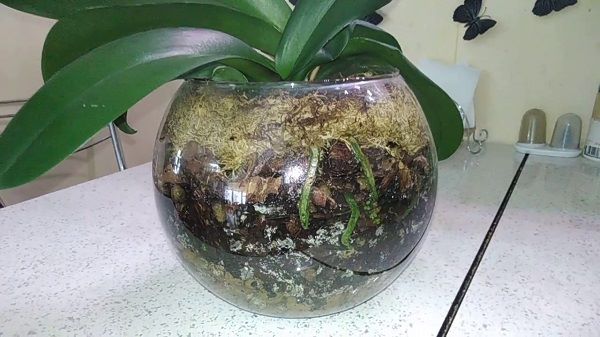

Phalaenopsis in a closed system.
You can get more information about the closed system here.
In water
The method is based on the principles of hydroponics and got the name - open cultivation system... Not all types of orchids can be cultivated in this way, are better suited for this:
- Phragmipedium;
- Phalaenopsis (grows more slowly than standard growing);
- Cattleya;
- Mormodes;
- Oncidium;
- Dendrobium;
- Miltoniopsis;
- Zygopetalum.
Important! Orchids grown by the open method should not have a pronounced dormant period and the required root drying.
Optimal is transparent container, corresponding in volume to the root system. The roots are not in the ground, but constantly in the water.
Conditions and requirements:
- the water temperature should be 2-3 ° less than room temperature;
- weekly water change;
- the roots must be constantly covered with water until they emerge from the plant;
- temperature and lighting should match the characteristics of the species;
- additional nutrition is introduced throughout the growing season, with a decrease in concentration by 2-3 times.
Read more about growing in water in this article.
In the greenhouse
A greenhouse or mini-greenhouse is necessary when certain conditions are created, which is not always possible in conditions of spacious apartments or insufficient temperature or humidity.
This design easy to make yourself from improvised means. There is plenty of information on making a mini greenhouse or mini greenhouse on Internet sites and forums.
The greenhouse is especially useful for resuscitation. orchids, which, for whatever reason, remained practically rootless.Stable maintenance of temperature and humidity are important conditions for rehabilitation.
You can read in more detail about how to make a greenhouse yourself in this article.
Features of phalaenopsis care
The flower feels best in conditions that are as close to natural as possible. In nature, orchids always hide in the shade of trees or rocks. Thick roots cling to cracks in stones covered with a thin loose layer of soil, moss, and plant debris. Abundant dew falls at night, and the flower stores moisture to help it survive the heat of the day. The roots of the plant are covered with dead spongy tissue - velamen, which retains water and nutrients "in reserve".
All that phalaenopsis needs is warmth, light, uniform watering and a little fertilizer. A uniform flow of moisture is ensured by a substrate that absorbs water well: boiled pine bark and sphagnum moss. It is necessary to water the plant when the substrate dries up from above, but inside it remains slightly damp.
Signs of improper care for phalaenopsis:
- new leaves are smaller than old ones;
- the abundance of aerial roots may indicate excessive watering, although occasionally there are hybrids prone to their formation;
- rotting of the roots in the substrate and the base of the stem (what some growers call the neck, although the phalaenopsis does not have a neck) is a sign of excessive watering;
- the appearance of hairs on the roots indicates the absence of velamen. This happens if the plant receives too much moisture, which is why it ceases to store it for future use;
- rotting of the middle of the stem or growing point is a consequence of a lack of moisture;
- premature wilting of flowers, dropping of buds is a sign of a lack of moisture or light;
- yellowing of leaves starting from the stem is a signal of improper watering. This happens when the stem decays. If the leaves start to turn yellow from the end, this is normal.
It is prohibited:
- fertilize diseased plants;
- water the orchids with water, in which they washed meat, fish, with an infusion of banana peel: all this leads to the appearance of pathogenic fungi and decay of the roots;
- "Polish" the leaves with beer. Healthy leaves should shine and have good turgor;
- treat the leaves with laundry soap from insects (the alkaline environment is harmful to orchids).
For foliar dressing, the leaves of healthy phalaenopsis are wiped with a solution of mineral fertilizers for orchids every 2-3 weeks (during the period of active growth).
The flower painfully tolerates a change in the watering regime. For example, in stores, plants are watered abundantly, so velamen is often absent on the roots. If the purchased flower is not watered for a long time, it will get sick. In the same way, it will react to suddenly more frequent watering after a long drought.
Secrets and expert advice
There are no special secrets when growing orchids. Knowledge of their species and hybrid characteristics provides complete information on the care and creation of conditions for growing. The main secret lies in the desire and love for floriculture.
The conditions of the apartment are quite suitable for the cultivation of many varieties of orchids. AND if you deal with them on a serious level, then tropical pets will only bring pleasure.
You can find more information about the secrets of growing orchids here.
Choosing orchids when buying
The importance of studying the variety before purchasing and growing orchids on your own has already been said. Now it is necessary to parse the question, how to choose an orchid when buyingwhat you should pay attention to.
So, when choosing orchids, you should pay attention to four important factors:
- Root system - choose only those that are planted in transparent pots, this will make it easier to determine the state of the flower. Pay attention to the color of the roots - they should be green or grayish. At the stage of active growth, the ends of the roots are always colored green. The same aspect guarantees the fact of the health of the plant.Do a little test - shake the pot in your hands. The plant should not "dangle" in the ground.
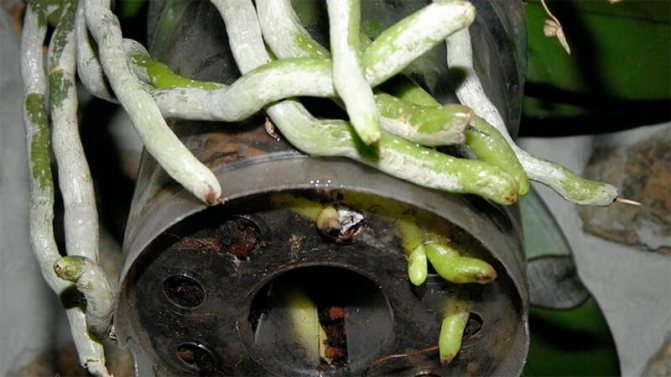

- Leaves - should be firm and dense green or close to herbal shade. Some varieties must have a red border. The surface of the leaves should be flat. The "accordion" of the leaf indicates a lack of moisture, and a too dark shade indicates growth in the shadow zone and a lack of sunny color.
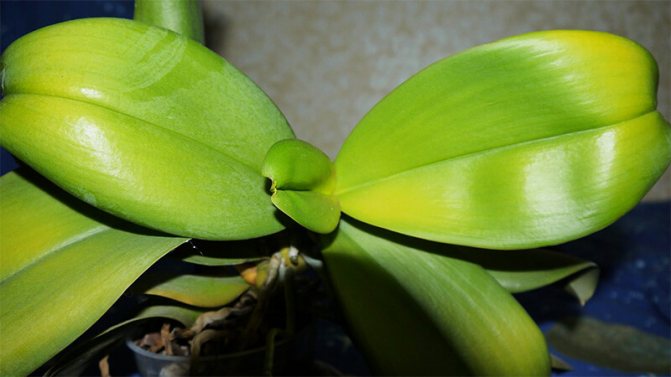

- Peduncle - blossoming flowers should be even and resilient. It is better to purchase those specimens where, along with the flowers that have opened, there are also newly developed buds. Otherwise, you run the risk of being without a beautiful inflorescence after the acquisition. When changing its place of residence, the orchid can shed existing flowers.


- Age - Orchids can be divided into mature specimens and seedlings. The seedling is still at the stage of leaf formation; the absence of a peduncle is noted. It may take several more years before you can enjoy the beauty of the flowers. It is better to choose mature individuals, since they can please with flowers in the near future of flowering.
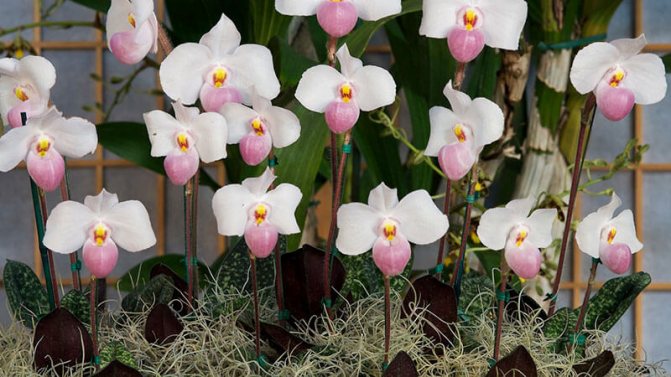

If you do not have certain experience and knowledge about growing an orchid from the moment of planting a seedling, it is better to choose already mature specimens in order to carry out all the actions for growing a flower and enjoy its beauty.
Pros and cons
Soil cultivation is inferior to hydroponics and hydrocultivation in some areas.
Benefits of growing without land.
- No rot and parasitesin soil (an important point). Orchid roots are initially subject to decay processes. But if you cultivate the hydroponic method, then there will be a large amount of oxygen in the water, and a regular change of liquid will also prevent decay.
- No need for regular transplant, as is the case with soil growth.
- The flower is not exposed excessive load of feeding.
- Water is constantly being enriched nutrients, so flowers grow strong and healthy.
- The roots do not dry out from oxygen deficiency.
But the cons also have to be mentioned. So, the water method requires constant control of the temperature of the water - it must remain cool. Also, the florist is forced to ensure that the water limit marker does not fall below the starting root system. If this happens, the liquid must be topped up.
Top dressing should be done throughout the entire growth period. This means that grooming requires regularity.


Features of growing in pots in an aquarium
How does an orchid grow in an aquarium? Orchids growing behind glass walls fit perfectly into the interior not only in offices, but also at home. In the photo you can see how orchids grow in an aquarium.
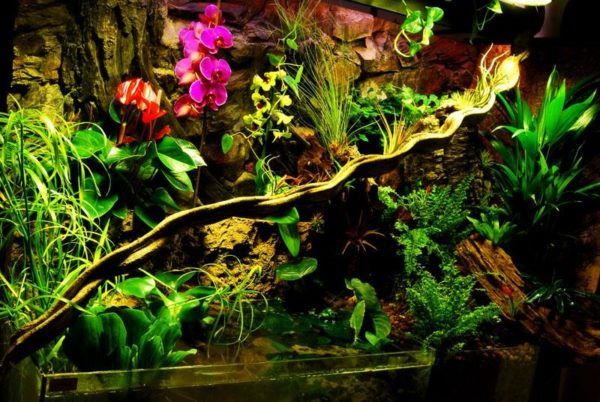

Orchids in the aquarium fit very well into the interior of the apartment.
What is also very important, they do not require special care if provided with enough:
- Sveta;
- Temperature;
- And moderate watering.
Some varieties can grow even without a substrate, feeding on humid and fresh air, only occasionally dipping the root system in the feed water.
What kind of orchid aquarium do you need? The aquarium is not quite the correct concept when growing orchids. It would be more correct to call:
- Terrarium;
- Paludarium;
- Or florarium.
Although there is one species that is able to grow in water - Odorata.
The peculiarity of placing orchids in flower pots in terrarium aquariums is:
- In the correct watering;
- And airing.
The microclimate of the aquarium is quite favorable for them and is very close to natural. The main thing is to ensure timely air circulation inside the container, especially in the area of \ u200b \ u200bthe root part.
Important! Stagnant humid air contributes to the development of fungal diseases.
How to transplant?
An orchid grown from seed is afraid of replanting. Because the soil clod can collapse and the roots will rot. Remember, the transplant should be done after the flowering period has passed.


Plant transplant
Why do many people resort to transplanting an orchid grown from seed:
- The old container is small
- Living and dead roots intertwined
- Salted soil
- The container is damaged
- Formation appeared on the substrate
Consider the transplant process:
- We carefully remove the roots from the container, trying to damage them less (you will probably need to cut the pot).
- We release the roots from the old soil.
- Cut off the roots that are rotten and dry with scissors.
- Rinse the roots carefully with water.
- Pour soil into a new pot on the base.
- We place the flower in a container and fill it with new soil.
- Moisten the soil slightly.
Basic rules for planting a popular tropical plant
If you decide to grow a healthy and beautiful plant in your home, then you need to follow the basic rules of care, and then it will delight you with its flowering for a long time.
Frequent growing problems
Beginners often have difficulty growing Phalaenopsis. This is mainly related to learning the process: how often to water or spray the plant so that the water is supplied as much as needed. Sometimes it happens that several plants die while the grower learns to see the needs of the orchid.
Roots rot
This is due to excessive moisture in the substrate: water does not drain from the sump, too much comes in. Rotting can begin due to the use of poor-quality liquid or low temperature. When the microclimate is disturbed, the plant weakens. The immune system is unable to fight the fungal spores that constantly attack living tissues.


Orchid does not bloom
Most likely, the plant does not have enough light. If the fertilizing was not applied at the prescribed time, the orchid will not have enough strength to tie the buds, there will be few of them. Overdrying the substrate also leads to a weakening of the protective forces. If the pot is too spacious, all the plant's strength will be spent on root growth, therefore, when transplanting, its volume is increased 4 cm wide.
Yellow leaves
The lower leaves turn yellow when the plant goes into dormancy. You don't need to worry about this: when the leaves dry up, they are cut off.
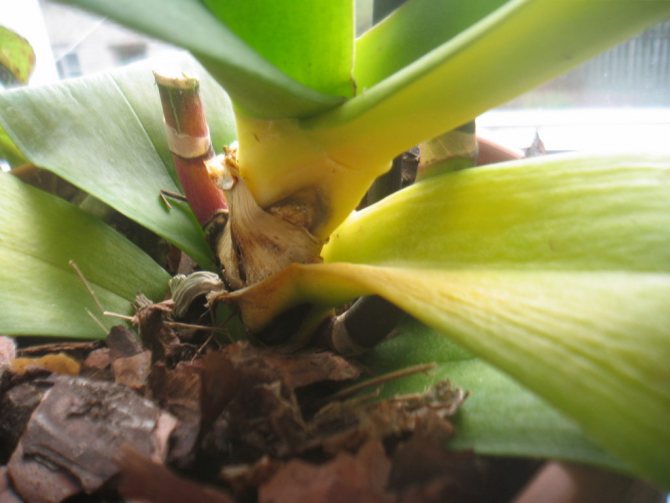

The essence of the method
In order for a plant to constantly delight with its flowers, it does not need ordinary water, but a specially fertilized liquid. All substances that are added to the water are determined strictly according to proportions, only this can ensure uniform nutrition of the flower.
Groundless method options:
- hydroponics - the plant is grown in water;
- aeroponics - a flower develops in the air;
- hydroculture - a substrate is added to the growing liquid.
Growing an orchid in water is not particularly difficult, it is dictated by the natural needs of the flower. Initially, it does not require soil, which is why the option of aquatic cultivation appeared. This method has many advantages, but there are also disadvantages.
How are they grown on an industrial scale?
Most of the orchids sold in our stores are grown in greenhouses and greenhouses. When buying an orchid, we can find out where it was grown:


Wherever it is grown, the process of its growth begins from the baby stage. Orchid babies grow in trays for 30 weeks. Greenhouse workers check the condition and appearance of the children as they grow.- Next, the children are transplanted into a transparent (namely transparent) pot, in which they will grow in the greenhouse. Children are transplanted exclusively by hand.
- Then a label is attached to the pot with information about the orchid (name and color).
- Then the orchids are sent to the greenhouse, where they are grown for 10 weeks.
- After 10 weeks, the orchids enter the workshop, where they are placed in a special plastic pot. In such pots, orchids receive the same growth conditions: the amount of water and space. They are in this pot for 16 weeks, and then they are placed in a larger pot and stay in it for 3-4 weeks until the flower stalk begins to grow.
- Then the orchids are placed for 8 weeks in a special cold part of the greenhouse with a temperature of 19 ° C.
Attention! After 20 weeks, orchids go to stores, and only then to our homes.
What kind of lighting is needed?
For the full cultivation of a finicky orchid flower, well-chosen lighting is necessary. They love as much scattered rays of the sun as possible, but not direct rays. If enough light falls on the plant, then it will delight you with its flowers, if not, then the surface of the leaf will begin to acquire a green color, it will begin to slowly stretch out and acquire a yellow tint.


Flower content
In the summer, when there is a lot of bright sunlight, the flower needs to be darkened, especially the roots. This is necessary so that the plant does not burn its leaves. Over time, it will be able to adapt to the bright rays of light after winter. You can use a matte film or plastic for darkening.
In the autumn, when the intensity of the sun's rays decreases, darkening is not required, at this time the plant falls into a dormant period, shoots begin to ripen, and new buds appear.
Suitable varieties
More and more new types of flowers appear on the market, but not all are suitable for growing in water. Phalaenopsis get used to hydroponics very well.
Plants without a dormant period are preferred:
- fragmipedium (otherwise it is called Venus shoes) - originally from the mountain tropics;
- cattleya - he has very large flowers, he loves warm conditions, but certainly not hot;
- dendrobium - grows in a cool natural environment;
- mormodes - has spots and dots on the petals, sepals;
- zygopetalum - it is distinguished by an unusual shape of petals.


It cannot be said that a flower in water is protected from pests. And although ground parasites do not reach him, there is nowhere to hide from the flying ones. If you have fixed whitefly butterfly near the orchid, wipe the leaves with a soapy solution made in a 1: 6 ratio.
Translation: what you need to know
Plants are transferred to the open system gradually. At this time, they should not bloom, release flower stalks. Main steps transplants:
- release from the bark (should be carefully peeled and rinsed);
- introduction to the mode "2 days in the aquatic environment - 1 day of drying" during the first week;
- lengthening the water gap up to 5 days with 1-2 "dry" days (second week);
- after a month - constant maintenance with a weekly change of liquid and rinsing the pot.
At this time, you need to very carefully monitor the reaction and well-being. Some of them require a longer drying time, such as Cattleya. A silvery color will indicate the need for moisture replenishment. Sometimes mold appears on the root system. It can be removed with a cotton swab moistened with fungicide or hydrogen peroxide. Can be sprayed from a spray bottle.


To make the experiment as successful as possible, without sad consequences experienced florists advise:
- try the technique in spring or early summer, when the flowers are active and the results will be faster and more obvious;
- in the warm season, exclude stimulation in the form of drying;
- if the transplantation took place during the period of suspended animation (in winter or autumn), you can pour the plant to the base of the neck for about a day, and then leave it in an empty flowerpot for a day or two;
- when immersed after drying, add a little peroxide - to saturate the liquid with oxygen and prevent rot;
- to find a favorable place for keeping in the aquatic environment - sufficiently illuminated, warm (20-23C, humidity 60-75%); cool window sills with drafts in this case will not work.
Water must be softened - rain, thawed, boiled, settled. You can filter it with peat. It is very important to take care of the leaves - to clean them of dust and dirt. With the help of this organ, orchids breathe, maintain moisture balance, and accumulate food.The leaf is, among other things, an indicator of health. Sometimes a yellowing or stain detected in time helps to save the pet.
Note! According to experts, velomen radically changes its cellular structure. So much so that the entire system dries up and dies if you plant it in a substrate. In order for it to take root in a closed soil system, it is necessary that most of it is not "watery".
For many connoisseurs, the sight of an exotic plant in a "glass" does not give aesthetic pleasure, it seems to be something temporary, unfinished. Very important moments disappear from the care system: the joy of interaction, aesthetic pleasure from the structure of the soil and the beauty of flowerpots. Conservative owners reject incomprehensible trends, remain loyal to a closed system. And everyone, no doubt, has the right to follow their own preferences.
Content in flasks


The difference lies not only in their beautiful blooms, but also in breeding methods. While many flowers grow on the ground, orchids grow from tree bark, clinging to it. They receive useful components and moisture with the help of aerial roots. Moisture comes from air or fog, and useful components from their own residues, which accumulate in the bark of the tree. But such a process takes place in the humid tropics, where the habitat for orchids is very suitable. It is impossible to create such an atmosphere in room conditions. There is more than one method for growing an orchid:
- growing in water - hydroponics;
- orchid without substrate and liquid;
- cultivation in soil.
If the roots of the plant are constantly in the liquid, then their rotting will begin. Therefore, they should not be completely submerged, but above the liquid. It is not necessary to switch to content in a flask right away, especially with regard to the flower itself:
- First, you need to pull it out of the ground, peel the roots, immerse it in water for a couple of days, and then dry it the next day. It is not necessary to drain the liquid completely, but so that the roots are still immersed in it by one centimeter.
- After a week, the orchid can be left in water for several days, but one day should be allowed to dry.
- After that, leave the phalaenopsis in the water for the whole time, changing it and observing the condition of the roots. If they change color to silver, then the flower needs to be watered.
At this time, the growth of new aerial roots will be noticeable, and green shoots will begin to appear on the old ones.
Note!
With this method, growing can be difficult due to root rot. To cope with it, the flower needs to be pulled out of the water for a day and the roots should be treated with a fungicide.
If algae have appeared on them, then you should not get rid of them, as this helps air exchange. A small part of the roots die off if the habitat has changed to aquatic, and instead of them appear those that are adapted for the plant to stay in water.
To prevent the appearance of fungus, you need to use a semi-hydroculture - an unusual substrate that does not give the flower any nutrients, but keeps it in a standing position. The flower receives all its nutrition through fertilizers, which are diluted in water. They are easily assimilated, and therefore do not spend a lot of energy, directing it to development.
Growing algorithm
To propagate a flower, you need to make several manipulations. First, cut the peduncle off the main plant. Then prepare a bottle with a neck cut 5 cm.
Submerge the plant in water, but the water should cover the peduncle by a maximum of 5 cm. Dissolve one tablet of activated carbon in the liquid. But do not take water from the tap, the orchid needs rain or pre-purified water.
Then do the following:
- with a sharp blade, cut off the semicircular flake of the flower - so the closed bud will become free;
- lubricate the place of the cut with a special ointment - cytokinin ointment can be bought at any flower shop;
- apply the ointment once every 7 days for about a month;
- it is recommended to change the water and the bottle itself once a week.
Why is it possible
Epiphytic plants generally don't need soil to feed. One of the few, they are able to adapt to different habitats. Unique roots help them firmly anchor on a rock or trunk of a tropical giant. Extract moisture from the atmosphere and necessary trace elements from natural organic composts.
Outer shell of scout roots - veloman - is able to rebuild its own cellular structure under changing conditions. The air root, encountering an obstacle in nature, stops working only to absorb moisture, tries to catch on, to hold on. The velomen in this area becomes thinner, additional hairs begin to grow on it.
If you put a tropical exotic in an aquatic environment, it will gradually adapt to life in it.
Diseases and pests
Reference! If you are having difficulty growing, it is possible that your plant is sick or pests are interfering with it.
Orchid pests:


aphid - if insects are slightly washed off with water, if severe damage - use soapy water;- wood lice - place a pot with a flower in a bowl of warm water (you can use soap) for 5-7 minutes, the insects will float up on their own;
- roundworms - place the flower pot in hot water (40 degrees) for 60 minutes, but there is a risk of plant death, it is better to use Fitoverm;
- shield and false shield - cover the soil with oilcloth, wash off the tubercles from the plant, treat with insecticide, after 5-7 days treat with soapy water;
- thrips - treat the plant and root system with Fitoverma emulsion concentrate, transplant, repeat the treatment three times in 5-7 days;
- mealybug - treat the substrate and the aerial part of the orchid with an insecticidal preparation, inspect the leaves and remove the individuals found;
- whitefly - close the pot with soil with a plastic bag, wash off all whitefly larvae from the surface of the orchid, soaked in soapy water with a cloth, treat the substrate with Fitoverm or Aktellik;
- cobweb mite - wash the entire plant with soapy water, treat the place where the plant stood, treat with an insecticide and close it in a plastic bag for 4 days, a week after removing the package, inspect it, if necessary, treat it again with an insecticidal preparation.
Orchid diseases:
- bacterial spots on the leaves - cut off the leaves, brush with rock salt and wash it off immediately, do not leave it on the plant;
- powdery mildew - water the plant vigorously, after 3-4 hours treat it with carbendazim or flutriafol;
- sooty mushrooms - treat with difenoconazole preparations, wait 2-3 weeks, if it has not improved to cut off the affected leaves;
- rot - cut out the places of rot with a disinfected knife, sprinkle with charcoal.
In the video, possible diseases and pests of orchids are examined in detail, options for treating a flower are considered.
About tap water
It is not very correct to put the flower in the water from the water supply. Chances are good that the roots will start to rot. This method is strictly used to strengthen and multiply the roots. There is only one variety that can easily tolerate tap water - Wanda. By the way, it can also be grown in a glass vase.
If you decide to keep a flower in a vase, constantly change the water, and keep an eye on the constancy of the temperature.
Sometimes between waterings, let the roots of the orchid dry out.


The process of planting a flower in water
Landing is done in several stages:
- clean the plant from soil residues;
- pour the substrate into the pot up to the level of the holes made in the walls;
- put the plant and straighten the roots;
- pour a solution of nutrients (bought in a store depending on the period of development: rooting, flowering, etc.);
- add the substrate to a level of 1.5 cm from the holes in the container.
The amount of the substrate can be adjusted depending on its type:
- expanded clay is poured to the middle, the flower is placed, then poured to the top;
- when applying perlite, a layer of expanded clay is first put on the bottom, then the plant and the perlite is added to the level of 1 cm from the holes; for compaction, the substrate must be immersed in water;
- diatomite also alternates with expanded clay (bottom and top) and is poured to the beginning of the holes;
- greenmix must first fall asleep, spill water to the holes, then pour the nutrient mixture.
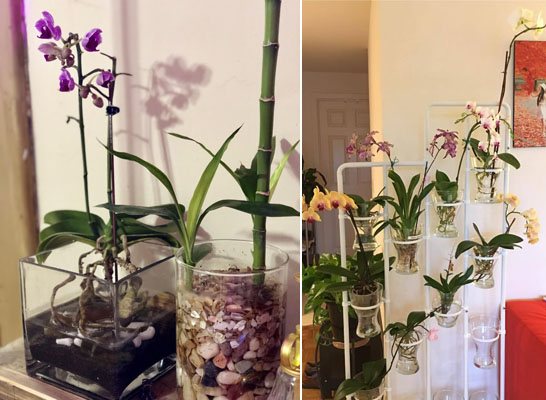

How to reproduce?
Consider how to propagate orchid seeds.
If you decide to do such a pleasant activity as growing orchids, and you know all its features, you can start propagating orchid seeds. Her reproduction in the house is the work of flower growers who have extensive experience in this matter.
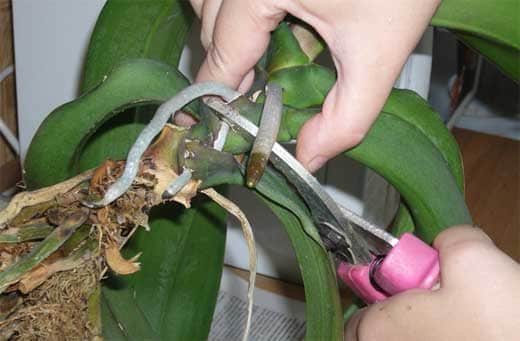

Reproduction of an exotic flower
The orchid reproduces from seeds:
- dividing large plants,
- with the help of side shoots,
- apical cuttings,
- pseudobulbs,
- kids,
- seeds.

